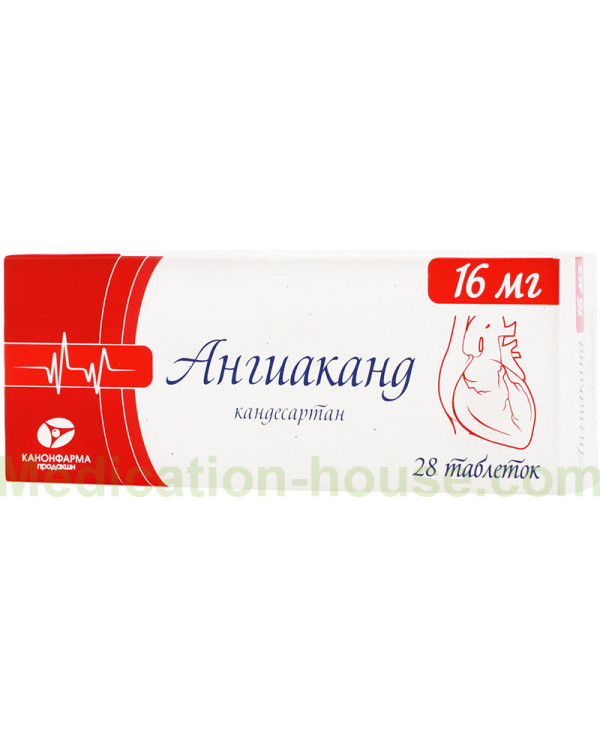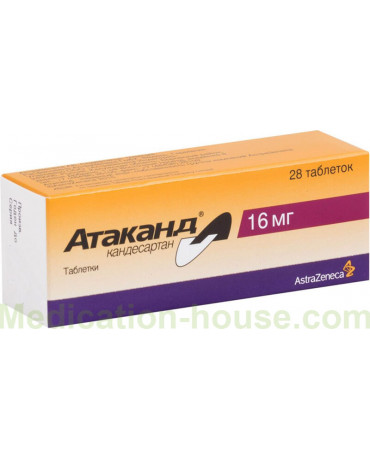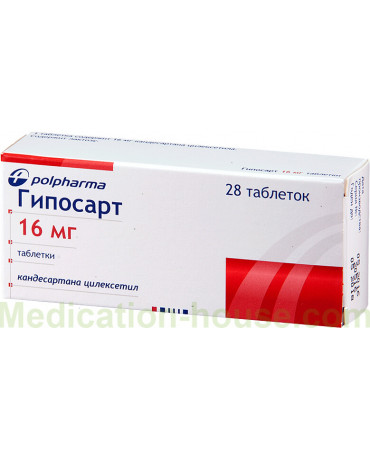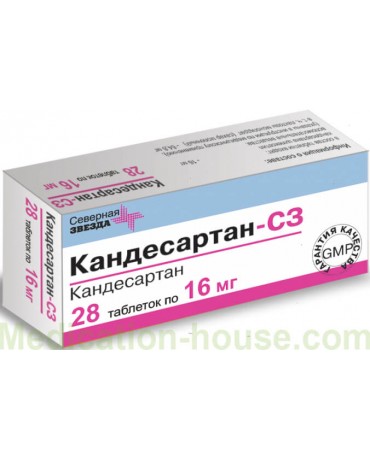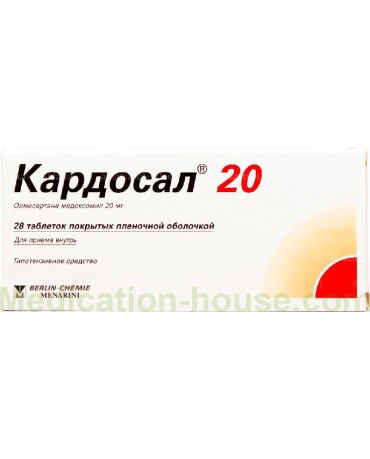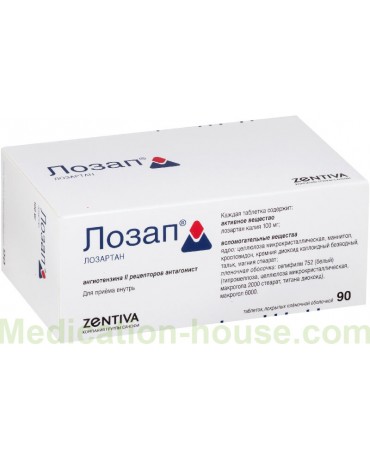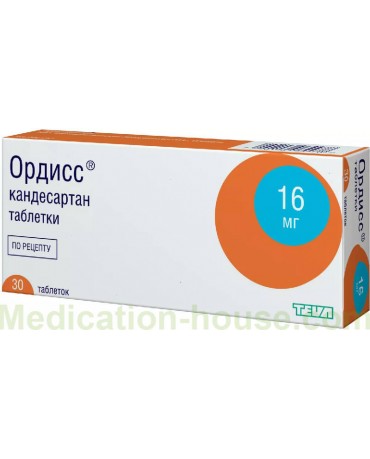Instruction for use of Angiakand
Reed more and buy Angiakand on this page
Angiakand is a drug with hypotensive, diuretic and vasodilating action.
Release form and composition
The drug is produced in the form of tablets: biconvex, round, almost white or white (7, 10, 20, 28 or 30 pieces in a blister strip; in a cardboard box 1, 2, 3, 4 or 8 packs of 7 pieces each. ; 1, 2, 3, 4, 5 or 6 packs of 10 units; 1, 2 or 3 packs of 20 units; 1 or 2 packs of 28/30 units, as well as instructions for the use of Angiakand).
1 tablet contains:
active substance: candesartan cilexetil - 8, 16 or 32 mg;
additional components: lactose monohydrate (milk sugar), croscarmellose sodium (primellose), magnesium stearate, pregelatinized corn starch, povidone K30.
Pharmacodynamics
Candesartan is a selective antagonist of type 1 angiotensin II receptors (AT1 receptors), which forms a strong bond with them with further slow dissociation. Has a vasodilating, hypotensive and diuretic effect. Does not suppress angiotensin-converting enzyme (ACE) and does not promote the accumulation of bradykinin or pain substance P, does not bind to receptors of other hormones, does not lead to blocking of ion channels involved in the regulation of the functions of the cardiovascular system. Due to the inhibition of the AT1-receptors of angiotensin II, the active substance contributes to the emergence of a compensatory dose-dependent increase in renin activity, plasma levels of angiotensin I and angiotensin II, as well as a decrease in the level of aldosterone in plasma.
In the treatment of arterial hypertension, the therapeutic effect of Angiakand is caused by a weakening of the total peripheral vascular resistance (OPSR), but at the same time there is no effect on the heart rate (HR). After taking the first dose of candesartan cilexetil, there were no cases of severe arterial hypotension, as well as a withdrawal syndrome at the end of therapy. The onset of the antihypertensive effect is usually observed within 2 hours after taking the first dose. Against the background of continued treatment with a fixed dose of the drug, usually the maximum decrease in blood pressure (BP) is achieved within four weeks and remains during the entire course of therapy.
The active substance promotes increased renal blood flow and does not alter or increase the glomerular filtration rate (GFR), while the resistance in the renal vessels and the filtration fraction decrease. In patients with arterial hypertension and type 2 diabetes mellitus, it does not affect glucose level and lipid profile. Candesartan leads to a dose-dependent gradual decrease in blood pressure, the age and gender of patients do not affect the effect of therapy.
In the treatment of chronic heart failure (CHF), in combination with a decrease in left ventricular ejection fraction of less than 40%, as a result of the use of candesartan, OPSS and capillary pressure in the lungs decreased, renin activity and plasma angiotensin II concentration in the blood increased, and aldosterone levels also decreased.
Pharmacokinetics
Candesartan is an oral prodrug that is rapidly (by ether hydrolysis) converted to the pharmacologically active candesartan. After oral use of candesartan cilexetil solution, the absolute bioavailability of candesartan is approximately 40%. The relative bioavailability of the active ingredient in tablet form when compared with an oral solution is approximately 34%. The calculated absolute bioavailability of the tablet preparation does not depend on food intake and is on average 14%.
The maximum concentration (Cmax) in serum is observed after 3-4 hours. The plasma concentration of a substance in the blood increases linearly with increasing dose in the therapeutic range (up to 32 mg). Candesartan binds to plasma proteins almost completely - by 99.8%. The volume of distribution (Vd) is 0.13 l / kg.
In a small amount, with the participation of the isoenzyme CYP2C9, the agent is metabolized in the liver - about 20-30%, as a result of which an inactive derivative is formed. The final half-life (T1 / 2) is 9 hours, the substance does not cumulate, the total clearance is 0.37 ml / min / kg, the renal clearance is approximately 0.19 ml / min / kg.
It is excreted by the kidneys and with bile, mainly in unchanged form and to a small extent in the form of a metabolite: through glomerular filtration and active tubular secretion by the kidneys in the form of an inactive metabolite - 7%, in the form of candesartan - 26%, with bile - 10 and 56%, respectively ... Within 72 hours after a single oral dose, more than 90% of the dose is excreted.
Indications for use
arterial hypertension;
CHF and impaired systolic function of the left ventricle (decrease in left ventricular ejection fraction less than 40%) as an additional therapy to ACE inhibitors or in case of intolerance to the latter.
Contraindications
Absolute:
cholestasis and / or severe liver dysfunction;
primary hyperaldosteronism (due to resistance to treatment);
lactose intolerance, glucose-galactose malabsorption, lactase deficiency;
age up to 18 years;
pregnancy and lactation;
hypersensitivity to any component of the drug.
Relative (take Angiakand tablets with extreme caution):
hemodynamically significant stenosis of the aortic and mitral valves;
hypertrophic obstructive cardiomyopathy;
ischemic heart disease (CHD);
cerebrovascular diseases;
severe renal failure (CC below 30 ml / min);
stenosis of the renal artery of a single kidney, bilateral stenosis of the renal arteries;
a decrease in the volume of circulating blood (BCC);
a history of kidney transplantation (data on the treatment of candesartan in patients who have recently undergone kidney transplantation are not available);
hyperkalemia.
Angiakand, instructions for use: method and dosage
Angiakand tablets are taken orally once a day, regardless of the time of the meal.
In the treatment of arterial hypertension, the recommended initial and maintenance daily dose is 8 mg. If there is insufficient blood pressure control, the dose should be increased to 16 mg, while the maximum daily dose should not exceed 32 mg. In the case when Angiakand therapy does not provide a decrease in blood pressure to the optimal target level, it is recommended to begin concomitant treatment with a thiazide diuretic for an additional antihypertensive effect.
For the treatment of CHF, the recommended initial daily dose is 4 mg (it is also possible to use candesartan in another form of release). It is recommended to increase the daily dose to 32 mg or to another maximum tolerated dose by doubling it with an interval of at least 14 days. During the treatment of CHF, Angiakand can be used in combination with other drugs used to treat this disease, including diuretics, β-blockers, ACE inhibitors and cardiac glycosides.
Side effects
During the treatment of arterial hypertension with Angiakand, the following adverse events were most often recorded:
musculoskeletal system, connective tissue: back pain;
central nervous system (CNS): weakness, dizziness, headache;
laboratory parameters: an increase in the level of urea in the blood, a decrease in hemoglobin, hyponatremia, hyperkalemia, hypercreatininemia, an increase in the activity of alanine aminotransferase (ALT);
other reactions: respiratory infections.
In the treatment of CHF, the following side effects were most often recorded:
cardiovascular system: marked decrease in blood pressure;
urinary system: impaired renal function;
laboratory changes: hypercreatininemia, hyperkalemia, an increase in the concentration of urea in the blood.
The following violations were reported in post-marketing research on candesartan:
CNS: weakness, dizziness, headache;
musculoskeletal system, connective tissue: arthralgia, back pain, myalgia;
digestive system: nausea, increased activity of hepatic transaminases, hepatitis or impaired liver function;
hematopoietic organs: neutropenia, leukopenia, agranulocytosis;
respiratory system: cough;
urinary system: functional disorders of the kidneys, including acute renal failure in the presence of a predisposition;
allergic reactions: itching, skin rash, urticaria, angioedema;
laboratory parameters: hyponatremia, hyperkalemia.
Overdose
Symptoms of an Angiakand overdose may include dizziness, tachycardia, an excessive decrease in blood pressure.
In this condition, the patient is recommended to lie on his back, raising his legs above head level. If necessary, it is required to increase the BCC by infusion of 0.9% sodium chloride solution and use sympathomimetics, after which symptomatic treatment is carried out. Prescribing hemodialysis is ineffective.
Special instructions
Before starting therapy and periodically during its implementation, it is necessary to monitor blood pressure and renal activity (plasma creatinine concentration).
In patients with CHF during treatment with Angiakand, arterial hypotension may be observed. The reason for the appearance of this complication in arterial hypertension, as with the use of other drugs that affect the renin-angiotensin-aldosterone system (RAAS), may be a decrease in BCC, as noted in people taking high-dose diuretics. As a result, caution is required at the beginning of therapy and, if necessary, correction of hypovolemia is required.
While taking Angiakand, as in the treatment with other drugs that inhibit the RAAS, some patients may develop renal dysfunction.
Against the background of therapy with angiotensin II receptor antagonists during the period of general anesthesia and during surgical interventions, arterial hypotension may occur as a result of RAAS blockade. It is extremely rare to develop severe arterial hypotension, which requires intravenous fluid and / or vasopressor drugs.
Patients with severe CHF or kidney disease, including renal artery stenosis (as a result of the dependence of vascular tone and renal function on RAAS activity), are especially susceptible to drugs acting on the RAAS. Therapy with such drugs in this category of patients can lead to the occurrence of severe arterial hypotension, oliguria, azotemia and, less often, acute renal failure. The possibility of the appearance of such effects cannot be excluded during treatment with angiotensin II receptor antagonists. An excessive sharp decrease in blood pressure against the background of cerebrovascular diseases of ischemic origin or ischemic heart disease when using any antihypertensive drugs can cause the development of stroke or myocardial infarction.
Influence on the ability to drive vehicles and complex mechanisms
Since Angiakand can provoke the appearance of dizziness and weakness, caution should be exercised while taking it by patients driving vehicles or other complex and potentially dangerous machinery.
Application during pregnancy and lactation
In the course of experimental studies on animals against the background of the use of candesartan, damage to the kidneys of the fetus was recorded in the embryonic and neonatal periods. The mechanism of damage is believed to be related to the pharmacological effect of candesartan on the RAAS. The blood supply system of the kidneys in the human embryo depends on the development of the RAAS and begins to form in the second trimester of pregnancy. As a result, the threat to the fetus is exacerbated by the use of the drug in the II – III trimesters of pregnancy, since during this period drugs that have a direct effect on the RAAS can lead to fetal development disorders or adversely affect the newborn, up to death.
The use of Angiakand during pregnancy is contraindicated. In the event that pregnancy occurs during treatment with the drug, it must be stopped immediately.
Whether candesartan is excreted in breast milk has not been established, therefore Angiakand is contraindicated for use during lactation due to the possible undesirable effect on breastfed babies.
Pediatric use
Angiakand is contraindicated in patients under 18 years of age.
With impaired renal function
In patients with mild and moderate renal functional impairment, the Cmax and area under the pharmacokinetic curve (AUC) of the drug increase by 50 and 70%, respectively. T1 / 2 does not change when compared with those in patients with normal renal function. In patients with severely impaired renal function, Cmax and AUC increase by 50 and 110%, respectively, and T1 / 2 increases by 2 times.
Angiakand should be used with caution in patients with bilateral renal artery stenosis, with renal artery stenosis of a single kidney, or in patients with a history of kidney transplantation. When treating arterial hypertension in patients with mild / moderate renal failure (CC above 30 ml / min), there is no need to adjust the initial dose. Patients with a severe degree (CC below 30 ml / min) are recommended to take Angiakand at an initial dose of 4 mg 1 time per day.
Against the background of renal failure, as well as in patients over 75 years of age with CHF, renal function and serum levels of potassium and creatinine in the blood should be monitored (especially with increasing doses). In patients with severe renal impairment or end-stage renal failure (CC below 15 ml / min), clinical experience with candesartan is limited. When treating CHF in patients with renal insufficiency, a change in the initial dose is not required.
For violations of liver function
In patients with mild to moderate hepatic impairment, an increase in the AUC of candesartan by 23% was recorded.
Treatment with the drug in the presence of severe liver dysfunction and / or cholestasis is contraindicated. Patients with mild / moderate functional impairment of the liver during the treatment of arterial hypertension are recommended to take Angiakand at an initial dose of 4 mg 1 time per day (it is also possible to use candesartan in another form of release).
When treating CHF, patients with hepatic impairment do not need to change the initial dose of Angiakand.
Use in the elderly
During therapy, in persons over 65 years of age, AUC and Cmax Angiakand increase by 80 and 50%, respectively, when compared with younger patients. At the same time, the age of patients does not affect the degree of the antihypertensive effect and the frequency of occurrence of undesirable effects.
There is no need to adjust the initial dose in elderly patients.
Drug interactions
warfarin, hydrochlorothiazide, digoxin, enalapril, nifedipine, glibenclamide, oral contraceptives (levonorgestrel / ethinyl estradiol): no clinically significant interaction is observed;
lithium preparations: there is a reversible increase in the serum concentration of lithium in the blood and the occurrence of toxic reactions; with this combination, it is necessary to control the level of lithium in the blood;
non-steroidal anti-inflammatory drugs (NSAIDs), including selective COX-2 inhibitors and non-selective NSAIDs (acetylsalicylic acid in a daily dose above 3 g): the hypotensive effect of candesartan may decrease; with a combination of angiotensin II receptor antagonists with NSAIDs, the risk of decreased renal function, up to the onset of renal failure, is aggravated, which, in the presence of renal impairment, causes hyperkalemia, this combination should be carried out with extreme caution, especially in elderly patients; all patients need to ensure that they receive a sufficient amount of fluid; at the beginning of the course and during therapy, it is necessary to monitor kidney function;
antihypertensive drugs, including diuretics: the risk of arterial hypotension increases;
ACE inhibitors: against the background of CHF, the threat of adverse reactions, especially renal dysfunction and hyperkalemia, is aggravated; it is necessary to conduct careful observation and monitor laboratory parameters;
potassium-sparing diuretics, potassium-containing salt substitutes, potassium supplements and other drugs that increase serum potassium levels (for example, heparin): the threat of hyperkalemia increases;
drugs affecting the RAAS: there may be an increase in the concentration of creatinine and urea in the blood in patients with bilateral renal artery stenosis or stenosis of an artery of a single kidney;
isoenzymes CYP2C9 and CYP3A4: no effect of candesartan on these drugs has been revealed; the effect on other isozymes of the cytochrome P450 system has not been studied.
Terms and conditions of storage
Store in a place protected from moisture and light, out of reach of children, at a temperature not exceeding 25 ° C.
Shelf life is 2 years.
Reviews about Angiakand
According to a few reviews, Angiakand smoothly and effectively reduces blood pressure in hypertension. The maximum therapeutic effect, as noted by patients, in most cases is achieved within a month after the start of admission. The drug without sudden jumps helps to normalize blood pressure, including against the background of type 2 diabetes mellitus, without affecting glucose levels. It also has a vasodilating and diuretic effect.
Some patients attribute the disadvantages of Angiakand to the presence of adverse reactions and the slow development of the maximum effect of therapy.
Terms of sell
A prescription is not required to buy Angiakand.

